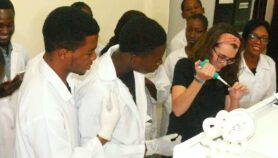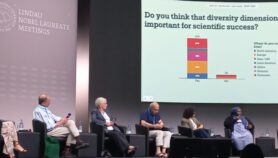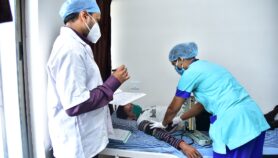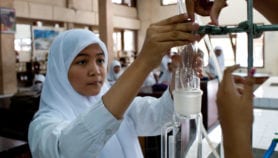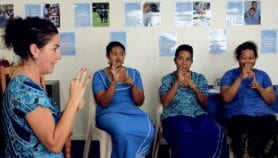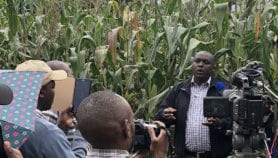Send to a friend
The details you provide on this page will not be used to send unsolicited email, and will not be sold to a 3rd party. See privacy policy.
Developing countries will benefit from creating more opportunities that allow women to make full use of their scientific capabilities.
One reason frequently cited for the low level of scientific activity in the developing world is a lack of resources. Yet there is a readily available resource that, for a complex web of social and cultural reasons, is still too often neglected in these regions: the brainpower of their women.
The picture is not uniformly bleak. Women play a significant role in the research community in Latin America and the Caribbean, for example, where they make up almost half (45.0 per cent) of the scientific workforce, well above the 33.9 per cent European average.
Indeed, the UN Educational, Scientific and Cultural Organization (UNESCO) Institute of Statistics estimates that several countries — Venezuela and Uruguay in Latin America, for example, Lesotho in Southern Africa, and both the Philippines and Thailand in South-East Asia — have more women scientists than men. In Myanmar, the figure is reported to be as high as 85.5 per cent.
Elsewhere, however, the record is poor. In both Mexico and Chile, male scientists outnumber their female colleagues by more than two to one, and the same is true for most countries in Africa. Only 14.8 per cent of researchers in India are women.
Countries cannot afford to ignore growing evidence that women’s increased participation in science can spur economic and social development. Both policy- and decision-makers need to be made aware of the correlation, and take active steps to overcome the many barriers that prevent women’s involvement in science.
Overcoming the obstacles
This week, we publish a series of articles in a Spotlight that explores why so much female talent is being overlooked in the developing world. We highlight the obstacles that prevent women entering or advancing in a scientific career and the steps that women — as well as their male colleagues — can take to promote gender equality in education and scientific research.
A background article by Jeanne Therese H. Andres presents the facts and figures about women’s under-representation in the natural sciences, highlighting gaps in gender-specific statistics and revealing an invisible web of barriers that begin early in life and continue long after women have attained advanced degrees.
This is complemented by a feature article in which SciDev.Net journalists report on how women scientists in five developing countries have fought to get to the top of their field. Their stories reveal both the challenges they faced, and what helped them succeed.
In the first of five opinion articles, Emily Ngubia Kuria, a neuroscientist at Charité University Hospital in Berlin, Germany, challenges misconceptions about women’s aptitude for science that persist even in academic institutions. The belief that the gender gap begins in primary school is misguided, she argues — secondary school is where girls drop out.
Naledi Pandor, South Africa’s Minister of Science and Technology, says increasing women’s access to scientific knowledge is vital for economic growth. And although gender equality may take time, countries can take practical steps to correct the situation.
Women themselves can take an active role in bridging the gap by teaching science, says Minella Alarcon, former senior programme specialist at UNESCO. Science teachers are in short supply, and teaching methods are out-dated. She argues that government funding to train the next generation of women scientists can make a difference.
Mentoring is another way to encourage female students to stick with the natural sciences, and Tineke Willemsen, social psychologist at Tilburg University, the Netherlands, lays down the ground rules. She explains how women can benefit from a mentoring relationship to help each other meet the challenges they face.
Finally, Mary Ann Mason, from the University of California at Berkeley, US, says that universities can be part of the force for change. She describes how child-friendly institutional policies can nurture a culture that puts men and women on an equal footing in their careers.
The road ahead
Women have succeeded in science as a result of their drive, and often family support. But success remains an exception, not the rule — there is no easy way to promote gender equality in science. This set of articles indicates essential components to any long-term solution.
Firstly, improving girls’ access to basic and secondary education — especially in science — is crucial. But access alone is not enough: without encouragement in the classroom and up-to-date teaching methods, girls may still turn away from scientific fields.
In the long term, educating girls can re-shape traditional beliefs, bring down cultural obstacles and gender stereotypes, and help transform girls into economic contributors. This socio-cultural transformation needs to begin at the household level and extend into the wider community.
For women scientists who reach higher education and launch their careers, institutional policies such as mentoring, childcare and funding can influence whether they advance or fall behind male colleagues.
On a national level, gender-specific data need to be collected to inform policy, and such statistics should be comparable between countries. With reliable data, specific priority areas in science and gender can be targeted for intervention, and progress in reducing the gender gap (or a failure to do so) can be documented.
To achieve development goals, more support and incentives should be provided to encourage girls and women to become scientists and innovators. Both countries and institutions need to consider gender issues in science as an integral part of their research policy, not just as an optional extra.
David Dickson, Director, SciDev.Net
Jeanne Therese H. Andres, Spotlight consultant
More on Capacity building
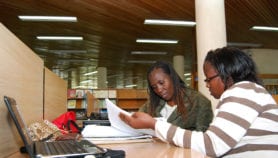
Script media release
Journalists offered ‘big break’ mentoring opportunity from Radio Nigeria
03/04/19






